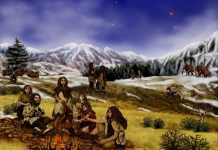
A new study from the University of Oxford suggests that kissing is far older than most people imagine.
According to the research, kissing likely evolved in the common ancestor of humans and the great apes around 21 million years ago.
The study also concludes that Neanderthals—our extinct human relatives—probably kissed too.
These findings, published in Evolution and Human Behavior, offer the first detailed look at the deep evolutionary roots of kissing.
Kissing appears across many species, yet it presents an odd biological puzzle. It can spread germs and doesn’t seem to offer an immediate survival or reproductive advantage.
Even so, in many human cultures kissing plays an important emotional, romantic and social role. Until now, researchers hadn’t seriously explored how and when kissing began.
The Oxford team took a new approach by studying the evolutionary history of kissing across primates.
Their findings show that kissing is not a modern invention but an ancient behavior shared by large apes.
The behavior likely emerged between 21.5 and 16.9 million years ago and has been passed down through generations of primates ever since. Today, kissing-like behaviors are still seen in chimpanzees, bonobos and orangutans.
The study also points strongly toward kissing among Neanderthals. Previous research already shows that humans and Neanderthals exchanged saliva through sharing microbes and that they interbred.
When combined with the new evolutionary analysis, the evidence suggests that kissing was a natural part of interactions between the two species.
To conduct the study, researchers first had to create a universal definition of kissing. This was more difficult than it sounds, because animals often engage in mouth-to-mouth behaviors that resemble kissing but serve different purposes, such as food sharing or aggression.
The team defined kissing as gentle, non-aggressive mouth-to-mouth contact with no food being exchanged. This allowed the behavior to be compared fairly across different species.
Using this definition, they reviewed scientific reports describing primate behavior and recorded which species were observed kissing.
Then they used phylogenetic analysis, essentially placing the kissing behavior onto the primate family tree to see how likely it was that ancient ancestors also kissed. They used Bayesian statistical modeling and ran the analysis 10 million times to build confidence in their results.
The research provides rare insight into a behavior that leaves no fossil record. Professor Stuart West, a co-author, explained that combining behavioral data with evolutionary modeling allows scientists to infer social behaviors in ancient species, even though these behaviors cannot be directly observed.
Although the study highlights the deep roots of kissing, it also shows that kissing is not universal among humans today. It appears in only 46% of documented cultures, and the meaning of kissing varies widely across societies. This raises further questions about how much of kissing is inherited biology and how much is cultural invention.
The researchers hope their work will guide future studies on social behaviors in animals and humans.
For now, the findings suggest that kissing is not just a romantic gesture but a behavior shaped by millions of years of evolution, linking us to our ape relatives and even to long-extinct Neanderthals.



